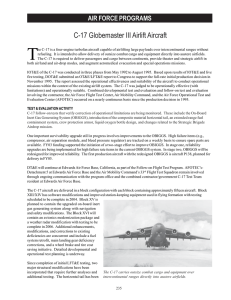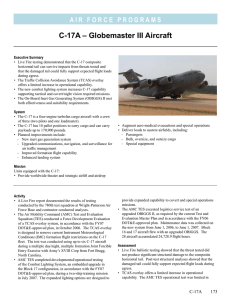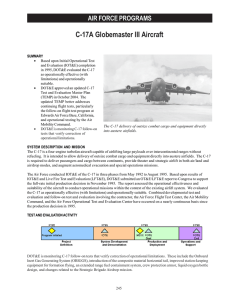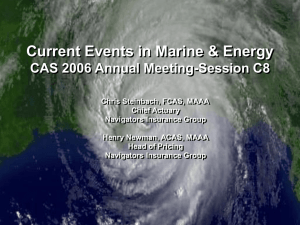An Australian Defence Force Perspective of the Humanitarian
advertisement
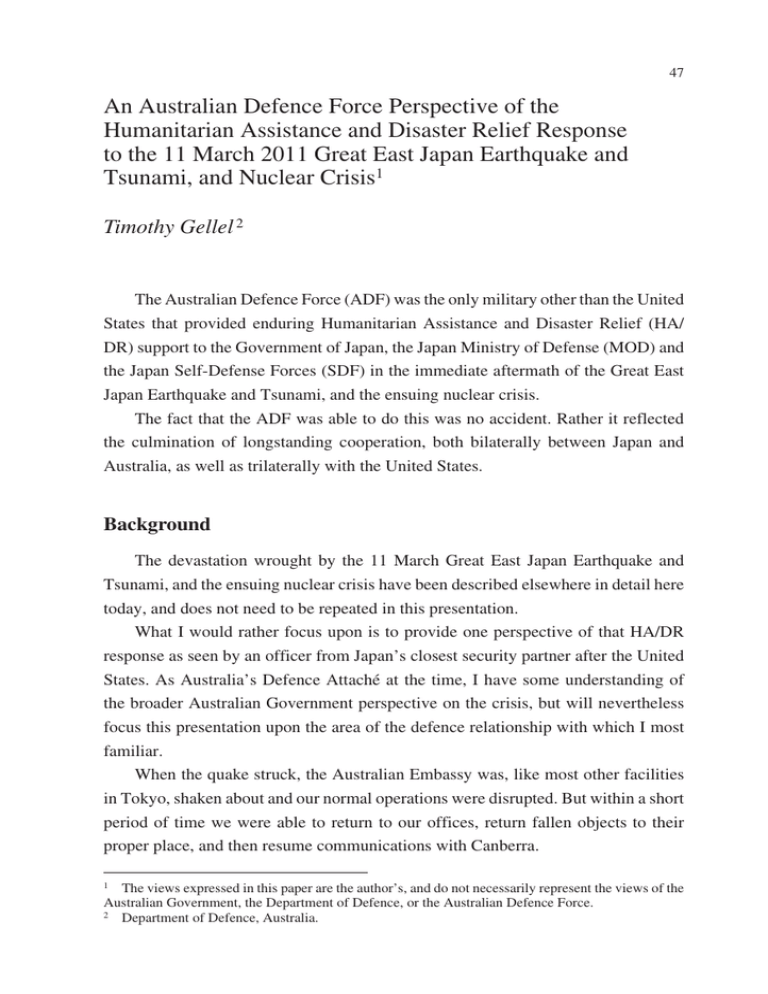
47 An Australian Defence Force Perspective of the Humanitarian Assistance and Disaster Relief Response to the 11 March 2011 Great East Japan Earthquake and Tsunami, and Nuclear Crisis1 Timothy Gellel 2 The Australian Defence Force (ADF) was the only military other than the United States that provided enduring Humanitarian Assistance and Disaster Relief (HA/ DR) support to the Government of Japan, the Japan Ministry of Defense (MOD) and the Japan Self-Defense Forces (SDF) in the immediate aftermath of the Great East Japan Earthquake and Tsunami, and the ensuing nuclear crisis. The fact that the ADF was able to do this was no accident. Rather it reflected the culmination of longstanding cooperation, both bilaterally between Japan and Australia, as well as trilaterally with the United States. Background The devastation wrought by the 11 March Great East Japan Earthquake and Tsunami, and the ensuing nuclear crisis have been described elsewhere in detail here today, and does not need to be repeated in this presentation. What I would rather focus upon is to provide one perspective of that HA/DR response as seen by an officer from Japan’s closest security partner after the United States. As Australia’s Defence Attaché at the time, I have some understanding of the broader Australian Government perspective on the crisis, but will nevertheless focus this presentation upon the area of the defence relationship with which I most familiar. When the quake struck, the Australian Embassy was, like most other facilities in Tokyo, shaken about and our normal operations were disrupted. But within a short period of time we were able to return to our offices, return fallen objects to their proper place, and then resume communications with Canberra. 1 The views expressed in this paper are the author’s, and do not necessarily represent the views of the Australian Government, the Department of Defence, or the Australian Defence Force. 2 Department of Defence, Australia. 48 The Role of the Military in Disaster Relief Operations One of our first duties was to account for our own staff and their families — in my case around nineteen personnel spread out across the Kanto plain — as well as visiting delegations. Once that was done we set out trying to ascertain the extent and nature of the disaster, but knew that with darkness about to fall, little would become clear until early the next morning at best. Doing nothing is sometimes a hard thing to do, but we had to fight our instincts to call or seek to visit the MOD on that first evening of the crisis. The first notification that Australia would send a C-17 aircraft came within an hour of the earthquake. There were no details, other than that the C-17 payload would be configured based upon what support and assistance the Japanese Government required. We received other calls too as staff officers sought to establish a phone hook-up between their ADO senior leadership and their MOD or SDF counterpart. We explained that in such a dynamic situation, and based upon the emerging information, the very large scale of the earthquake and tsunami and their impact, the MOD and SDF leadership needed time to take in the information that was staring to flow in. This was to be an unprecedented disaster for Japan — for any nation — and leaders and commanders needed time to come to grips with the situation, and could not afford to be distracted by well-intended phone calls. Part of my job as attaché was to encourage ADF and ADO leadership to provide that space and not to unwittingly impose upon the very busy men and women at the MOD. We told them to write letters instead. Of course technology did not stop those with the closest relationships from trading e-mails, or texting with their MOD and SDF friends. Cooperation with international partners did not come intuitively to the elements of the Government overwhelmed — as any government would be — by the scale of the earthquake and tsunami. But that also reflected the experience of other governments in advanced economies — neither Washington during Hurricane Katrina in 2005, nor Canberra during the January 2011 Queensland floods had turned to international partners for assistance in the first instance, nor had they made the most of all offers of assistance in the early days of the crises. In Tokyo, the Ministry of Foreign Affairs (MOFA) was identified as the formal madoguchi for foreign offers of assistance. But the MOFA was, understandably, not at the centre of decision making within the Government of Japan for this crisis, and nor was it familiar with coordinating offers of foreign military assistance in particular. Moreover, it is difficult to learn how to do something new in the middle of An ADF Perspective of the Humanitarian Assistance and Disaster Relief Response 49 a crisis. Nevertheless, Foreign Minister Matsumoto accepted an offer from Foreign Minister Rudd for the deployment of a civilian — State Government — specialized Urban Search and Rescue Team, similar to the one the Government of Japan had dispatched in response to the Christchurch Earthquake in New Zealand in February 2011. And the best means of deploying that team, their equipment and dogs was by ADF C-17 airlifter. That team’s arrival was delayed by the ADF’s unfamiliarity with the nature of the equipment the search and rescue team needed, and particularly how it should be loaded safely onto a military aircraft. Moreover, that aircraft was scheduled to return to Australia after it had deployed the USAR team, unless there was scope for it to make a meaningful and substantive contribution to the Japanese Government’s HA/ DR efforts. And that meant quickly finding suitable tasking for the aircraft. A further challenge was determining a suitable base of operations for the aircraft. To make the best use of the aircraft, pallet handling and load preparation equipment and space is required to maximize the aircraft’s sortie rate, and these were unlikely to be available at commercial airports in Japan. This argued for a deployment to an air force base, but as the C-17 is a heavy airlifter, not all JASDF bases, for example, have aprons capable of supporting the aircraft. We had not deployed — let alone operated — a C-17 to a JASDF base before, and with the crisis still unfolding, this was not the time to seek to establish that precedent. Like the rest of the Government of Japan, the MOD and the SDFs were, again, understandably, overwhelmed at the enormity and complexity of the tasks that confronted them, and now was not the time to be seeking to do something new. So, when we received advice that HQ US Forces Japan and the Gaimusho had agreed that US air bases in Japan could be used by foreign military forces in support of HA/ DR response to the earthquake and tsunami, we decided that the dual US 5th Air Force and JASDF Yokota Base would be the best location from which to base our C-17 operations. Having negotiated diplomatic clearance with Gaimusho for the C-17 to arrive into Yokota, and with blanket seven day approval for operations within Japanese airspace negotiated by MOFA with the Ministry for Land Infrastructure, Transport and Tourism, we also took the step of confirming that the MOD, Air Staff Office and the Joint Staff J4 knew that our C-17 was on its way, and that it would be available for tasking in support of the Government of Japan and the SDFs. Before the aircraft touched down at Yokota, we met with US Joint Task Force 50 The Role of the Military in Disaster Relief Operations (JTF) staff to request that the Royal Australian Air Force (RAAF) C-17 be integrated into their airlift operation and the Air Task Orders. This was to avoid a situation where the ADF element would need to establish a separate line of direct communication and tasking processes with the Joint Staff J4, who were already being taxed to coordinate what would be not only the largest logistics activity undertaken by the SDFs, but also the first Joint Operation. Our interaction with the JTF was coordinated through the Yokota-based Headquarters United Nations Command (Rear). Although this was not their normal task, the small HQ UNC (R) staff were experienced with cooperating with Sending States, such as Australia. From previous expert logistician discussions between our respective J4 Joint Logistic chiefs, we understood that the Joint Staff did not have a standing Joint Movements and Control Unit, but instead relied upon a contingency staff drawn from cadres from within the single services. Again, this was not the time for the ADF to further complicate what was already a most complex task for the Joint Staff. Instead, we relied upon our established interoperability with the US Air Force to slide into an existing, and already functioning system. Nevertheless, from the outset the MOD provided what assistance it could. The MOD and the Ground Staff Office assisted by meeting our request for maps of Minami Sanriku for the SAR team to use, as well as providing some other situational awareness information. And this was at a time when the as the central Government increasingly turned to the MOD and SDFs as the largest available national-government resource available to it to respond to disaster relief operations which exceeded any training scenario envisaged, let alone exercised. Once the first C-17 arrived, it quickly found additional tasking through the US 13th Air Force, and equally had no problems integrating into a familiar airlift structure. The RAAF C-17 commander identified the Australian preference to prioritize Japanese Government loads over any US loads that might need to be moved. At the time we did not appreciate what new cooperation milestones this might end up establishing. In total, that one C-17 flew 17 sorties, and moved over 450 tons of humanitarian stores and equipment, including: – 41 Japan Self-Defence Force vehicles – 135 Japan Self-Defence Force personnel – 45tons of palletized water An ADF Perspective of the Humanitarian Assistance and Disaster Relief Response 51 – Specialist runway clearing equipment for Sendai Airport Moving the Ground Self-Defense Force (GSDF) equipment and personnel from Okinawa (Kadena) posed some new challenges. The first of these was the complexity of loading personnel and unfamiliar equipment into our C-17. Fortunately, the RAAF C-17 crew included a suitably qualified linguist. In fact we might say an overqualified linguist, in that it is not a normal practice for a Wing Commander (Lieutenant Colonel) to assist a Warrant Officer or Non-Commissioned Officer Loadmaster. But the officer selected — Wing Commander Sonja Halloran — was not only one of the best Japanese linguists in the ADF, she also had three years experience as the Assistant Defence Attaché in Tokyo, and is the first (and so far only) RAAF officer to have graduated from Japan Air SelfDefence Force (JASDF) Staff College. So while WGCDR Halloran was over-ranked for the task — she was after all the senior officer on the aircraft — she was the best person to reduce the likelihood of linguistic or cultural misunderstanding, at a time when all participants were under enormous pressure to undertake something which had only been practiced in theory, in an environment where safety was of paramount importance. WGCDR Halloran also brought with her some other important experience, in that she was also one of a small number of RAAF personnel who was familiar with the Trilateral Australia-Japan-United States Pacific Global Air Management Seminar (PGAMS) program. That program, which had commenced in 2007, sought to enhance the ability of the three most capable air forces in the Asia-Pacific region to cooperate more closely on issues of strategic airlift in HA/DR scenarios. While that program was far from mature, it nevertheless provided a rudimentary framework for mutual understanding of the similarities and differences in the three nations’ respective approaches to coordinating strategic airlift. As part of that program, a study had been undertaken in 2007 to cross-load a GSDF CH-47J helicopter into a C-17. While this was limited to a static test, it highlighted the importance of understanding different processes for load configuration and certification, as well as drawing upon complementary asymmetries in the capabilities of the ADF, JSDF and the US military. Namely, while Japan possesses the world’s second largest fleet of CH-47 helicopters which are arguably the best rotary winged aircraft for international HA/DR missions, Japan’s exclusive self-defence policy has limited its airlift capacity, and with it the ability to quickly deploy these valuable and 52 The Role of the Military in Disaster Relief Operations much-sought after helicopters to areas where they might be needed. As a case in point, a shortage of airlift capacity meant that two of the three GSDF CH-47 deployed to Pakistan in response to the 2010 floods had to travel by sea, and only arrived days before Japan’s disaster relief mission there was concluded. Had our coordination been closer, it might have been possible for RAAF C-17 to have ferried the GSDF CH-47 to Pakistan in a more timely manner, especially given that the SDF deployment went to Multan where a combined Australian GovernmentADF medical team was also operating. Indeed, earlier in 2010, the ADF and Japan’s Joint Staff had examined whether it might be possible for RAAF C-17 to assist with the SDF deployment to Haiti, but issues related to the certification of the proposed load — in this case commercialgrade earthmoving equipment could not be resolved in the short period of time available. The lesson learned — or perhaps relearned — here was that it is difficult to cut corners in time of need. That lesson had been captured in the 2010 Australia-Japan Acquisition and CrossServicing Agreement (ACSA), which — prophetically — includes the provision for HA/DR cooperation in either Australia, Japan or a third country. And while that ACSA cannot yet be brought into force until the Diet passes the necessary amendments to the Self-Defense Force Law, it nevertheless provided an aspirational framework for both governments to work with. So this raises the question then, how was it that a RAAF C-17 was able to safely load and move GSDF vehicles from Okinawa to northeastern Japan when this had not been practiced before? The answer was that the GSDF vehicles had been moved in USAF C-17 many times before, and therefore the load preparation and tie-down configuration data was available after all. The high-level of interoperability and both platform and procedural commonality between the USAF and RAAF airlift crews meant that the RAAF loadmaster was able to use data derived from US and SDF bilateral cooperation and training to safely load the GSDF equipment onto the RAAF C-17 without any significant problems or delays. This demonstrated not only the value of close bilateral US-Japan and US-Australia cooperation and training, but also demonstrated how experience from our respective bilateral relations with the US both complements and can be leveraged to support our trilateral relationship as well as the bilateral Australia-Japan relationship. In summary, that PGAMS experience combined with the presence of a qualified and experienced liaison officer both increased mutual confidence in safety of the An ADF Perspective of the Humanitarian Assistance and Disaster Relief Response 53 airlift operation, and also mitigated the potential risks associated with establishing cooperation precedents under operational conditions. Nuclear Crisis But as fate would have it, just as we got the airlift cooperation working, a new crisis arose. We had been aware of some concerns about possible problems at the Fukushima No.1 Power Plant the day after the quake, but it was the sight of SDF CH-47 attempting to cool the reactors by dousing them with seawater from suspended buckets on 17 March which suggested that the situation was not under control. Again, the Government of Japan had turned to the SDF as the largest, most capable organization at its disposal to try and restore control to a growing, and unforecast problem. From visits to the MOD it was clear that this new problem, coming on top of the already devastating earthquake and tsunami, threatened to overwhelm officers and officials who had already been pushed to the limits of human endurance. As we visited the MOD, we could see weight of responsibility etched on the faces of these officers who had existed on the bare minimum of sleep for the past week, and for the first time we were gravely concerned. When we later received a request from the US Government to provide transport for specialized remote control pumping equipment from Australia to Japan, we knew the task was not going to be easy. For the Australian Government, the diversion of these aircraft entailed significant risks at the tactical, operational and strategic levels. At the tactical level, we already had one C-17 flying HA/DR missions through the airspace near the Fukushima reactor, and we badly needed information on the state of the reactor for the safety of the crew and aircraft. If they were contaminated, then the relief missions would have to be stopped. Again, we could receive much of this information from US Joint Task Force, who were after all confronted by the same safety concerns. But it was also important to obtain the MOD’s views, and for this reason we had to strongly request the MOD to provide us with the safety information. At the operational level, the Australian Government was taking a risk by diverting the two C-17 to the pump transport operation. In March 2011, Australia only had four C-17 aircraft, and one of these was in the United States undergoing scheduled, long-term maintenance. With one aircraft already committed to HA/ 54 The Role of the Military in Disaster Relief Operations DR missions in Japan, the request for two aircraft represented all that was left of our strategic, heavy-lift capability. Sending the aircraft to Japan with the pumping equipment meant redirecting them from essential resupply tasks for our deployed forces in Afghanistan, the Middle East and other operations. At the same time, the RAAF crews were being stretched to support domestic security tasks, as well as recoordinating the flow of supplies to and from operational theatres with the disruption caused by having all three operable C-17 committed to HA/DR tasks in Japan. At the Strategic level, the risk to the Australian Government was also complex. First, with all three operable C-17 committed to HA/DR tasks in Japan, there would be for a period of time no reserve strategic airlift capacity left back in Australia in the event of some other emergency, whether it be a domestic natural disaster in Australia, an urgent operational requirement involving ADF personnel elsewhere overseas, or some other regional crisis. Second, there was not very much information available about the possibility of radiation contamination of the aircraft once they arrived in Japan — while the assessed risk was low, more information was needed to complete that assessment. Lastly, the Bechtel pumping equipment that the ADF was to transport was at the request of the US Government, not the Government of Japan. While we were confident that close coordination was being carried out between Japanese and US Government officials, it was difficult to gauge Tokyo’s perception of the need for this equipment and how it might be used. What we did know was that several contingency plans were being worked by both Japan and the US at the same time, and it would be difficult to tell which plans ultimately would be used or needed. We went back into the MOD to seek more information on the evolving nuclear crisis. If nothing else, it allowed us to understand the situation in Ichigaya. The first 72 hours after the earthquake were marked by frenetic activity, as MOD and SDF staff sought to assess the enormity of the task confronting them. 72 hours is recognised as marking the usual limits of human endurance with out sleep, and at that point the MOD and SDF staff needed some rest. Field Marshal Slim’s famous dictum that a commander and his staff need eight hours rest each day, even at the height of a battle, if they are to remain effective remains valid, but a difficult standard to achieve. Instead, circumstances conspired against the MOD and SDFs as they were increasingly called upon to undertake a greater role in first the HA/DR operations, and then only a few days later in nuclear consequence management. Mission creep An ADF Perspective of the Humanitarian Assistance and Disaster Relief Response 55 was inevitable, because the SDFs represented the best — and often the only — asset available to the central government that was large enough and capable enough to undertake a growing list of tasks. Well-intended offers of foreign aid threatened to be a distraction for overtaxed staff, dealing with a dynamic and unprecedented series of challenges. The problem at the Fukushima power plant had yet to be defined properly, but there was little expectation of seeking more concrete answers to these sorts of questions. Nevertheless, the decision was made in Canberra to support the request, and to rearrange airlift support priorities so as to ensure that the pumps were available to the Government of Japan with one further contingency option. As events turned out, the Bechtel pumping equipment was used as part of Operation AQUA — a combined US military–JSDF operation to deploy emergency fresh coolant water to the stricken reactor. The pumps, packed on board the two RAAF C-17, arrived at the USAF Yokota ramp, to then be carried by Ground Self-Defense Force transporters to Onahama, where they were mounted onto two US Navy water barges, which were then towed to the quay alongside the stricken reactors by JMSDF crews. I cannot think of a better example of trilateral cooperation in an emergency than that. After Operation AQUA, the two-C-17 carrying the pumps returned to Australia to support our deployed forces in Afghanistan and elsewhere. One of them carried with them the USAR team who returned to Australia through Yokota. The final C-17 concluded its domestic HA/DR operations on 24 March, the Department of Defence worked through more support options to see if there was some further way that the ADF might support the Government and people of Japan. But experience from working in less-developed countries could not be applied to a leading first world economy like Japan’s. Whereas in a small South West Pacific Island nation, the ADF might become involved in rebuilding schools, or some other civil engineering tasks, those options were not relevant to the situation in Japan. Australia considered offering assistance with restoring Matsushima Air Base and the JASDF training capability, but again quickly concluded that these were tasks where Australian assistance was not required. Lessons learned for Australia Operation PACIFIC ASSIST was a successful one, in that it delivered assistance 56 The Role of the Military in Disaster Relief Operations to the Government and people of Japan. But that success reflected the significant investments made in the bilateral Australia-Japan, and Trilateral Australia-JapanUnited States defence and security relationships. As noted above, the discussions and negotiation about the Australia-Japan ACSA demonstrated Australian and Japanese government intent to cooperate on HA/DR operation, whether abroad or at home. The Pacific Global Air Mobility Seminar provided a practical framework for understanding the interoperability gaps as well as the similarities between our approaches to air movement. In addition to these processes, it was important to have the right personnel involved as well. The role played by WGCDR Halloran is but one illustration of the value of having experienced liaison officers who can apply their knowledge and skills to reduce the interoperability gaps even further. This is especially important given that it is not possible to train for each and every possible scenario, and some things will have to be improvised on the day. We also understood that the MOD and SDFs needed assistance, not more work. However well-intended, it was more important to provide practical assistance that met the needs of the people and Government of Japan by providing practical solutions. Moral support could come later. Familiarity with each other’s organization, including both their strengths and shortfalls was also essential. We understood that offering heavy airlift support could meet a requirement the SDF did not possess the capability to fulfill by itself. But whatever the success of the PGAMS engagement, this was not the time to try an establish a new bilateral Australia-Japan process for coordinating our airlift support to the Joint Staff, and so instead we worked through the US 13th Air Force Air Movements Control Centre. Equally, by explaining to the MOD our requirement for information — especially as it pertained to the nuclear crisis — was essential to informing Australian decision making processes that made our Government confident that the risks it was taking in sending all three C-17 to Japan were manageable. And lastly, there is of course a need to build upon this experience, and apply those lessons learned. I understand that they have recently been discussed at the Trilateral Australia-Japan-United States Security and Defence Cooperation Forum (SDCF) meeting. And I know that they will be included in our Joint Staff and airman-to-airman talks. It is important too these lessons are examined, and built upon through practical cooperation, such as in the regular PACIFIC PARTNERSHIP An ADF Perspective of the Humanitarian Assistance and Disaster Relief Response 57 or PACIFIC ANGEL exercises, as well as through mutual aircraft visits. The first bilateral RAAF-JASDF exercise — Exercise NICHI-GO DAWN — which included activities in Alaska, and at JASDF Misawa airbase in July this year, has been another important step in that process. And we look forward to seeing more regular visits by SDF aircraft and ships to Australia as well. More specifically, we hope too that the personnel changes continue, so that our relationships and mutual understanding continue to develop — and we especially look forward to the future attendance at Australian Staff College by a JASDF officer. Post-operation reviews such as this Symposium hosted by NIDS today provide an essential opportunity to reflect upon how we might learn from the past and improve our cooperation into the future. As the famous Japanese saying goes, “after victory, tighten your helmet straps.”
